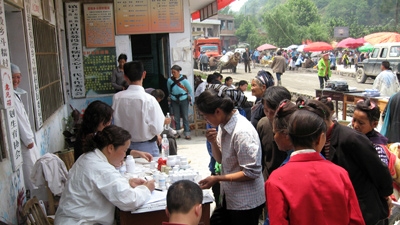Chongqing Urban and Rural Integration Project II was officially launched on November 8, 2012 by the World Bank and Chongqing Municipal government. The project supports the construction, renovation and upgrading of eight county and district-level hospitals in the non-urban areas of Chongqing municipality in Southwest China.
The project also aims to improve service efficiency and quality of care in these hospitals, through introducing new instruments and management techniques, staff training, and building management information systems.
These works are expected to complete in 2017. By then, 200,000 square meters of hospital space and 1,800 new hospital beds will be added, with highly-functional information management systems and telemedicine systems in place. 7 million residents in the eight project counties are expected to benefit from improved health services.
China is undergoing rapid urbanization – by 2020, 70 percent of its population will be living in cities. This has posed many challenges – disparity between urban and rural residents in access to basic health services is one of the most outstanding.
For example, in rural areas of Chongqing, compared with urban areas, infant mortality rates are higher and immunization rates are lower. There is also a big gap in hospital bed space, equipment and medical staff.
“We noticed there is a critical need to invest in rural health facilities and associated services to narrow the existing urban-rural disparities in health,” said Shuo Zhang, a senior health specialist at the World Bank.
The World Bank provides $100 million to support the Chongqing Urban and Rural Integration Project II. “The World Bank is very pleased to have the opportunity to be involved in China’s health reform and integrated urban and rural development in Chongqing,” said Toomas Palu, Sector Manager of Human Development, East Asia and the Pacific of the World Bank, at the launch ceremony.
Zhen Chiping, Division Director of the Foreign Capital Utilization Department of the National Development and Reform Commission (NDRC), said Chongqing is the only municipality directly under the central government in China’s less-developed western region and it is important to address the development needs of the people there. “This project targets medical facilities at the county and district level, which will contribute to the urban-rural integration,” he said.
Wu Jianjun, Deputy Division Director of the International Department, Ministry of Finance, said innovation is an integral part of the project which will have demonstration effects and its experience in health reform can be shared throughout the country.
The innovations the project promotes include construction of energy-efficient and green hospitals as well as modern hospital management tools, such as cost-accounting system, coordinated health care and continued quality improvement.
Tu Jingping, Deputy Secretary-General of Chongqing Municipal Government said the local government highly appreciates the project design, which focuses not only on hardware but also on “software” – building the capacity for medical professionals and hospital management staff. He invited all participants to come back to Chongqing in five years time to see the results of the project.
The launch ceremony was attended by senior officials from the Ministry of Finance, NDRC and Chongqing Municipal Health Bureau, Development and Reform Commission and Finance Bureau, as well as officials from the eight project counties.

